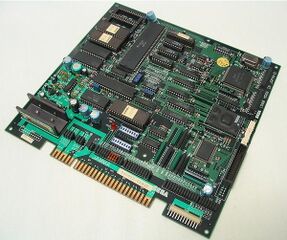Sega System C
From Sega Retro

| |||||||||
| Sega System C | |||||||||
|---|---|---|---|---|---|---|---|---|---|
| Manufacturer: Sega Enterprises, Ltd. | |||||||||
| Variants: Mega-Tech System, Mega Play, System 18, System 16, Mega Drive | |||||||||
|
This short article is in need of work. You can help Sega Retro by adding to it.
The Sega System C (セガ システム C) is an arcade board used by Sega between 1989 and 1994, and later used by Atlus from 1995 onwards for their Print Club series. It is based on the Sega Mega Drive hardware, using a slightly faster-clocked CPU and an improved VDP hardware. A slight update called the Sega System C2 was introduced in 1990. The Columns manual refers to the hardware as Sega System 14.
Contents
Hardware
The System C hardware is built on top of the Sega Mega Drive hardware, with the main CPU, sound and graphics processors remaining the same, albeit with a few differences that make them incompatible:
- The 68000 is clocked slightly faster (8.94 MHz instead of 7.67 MHz). The Z80 was removed; the faster 68000 allows it to handle sound without slowdown in games.
- The VDP no longer uses its internal CRAM for palettes. Instead, it relies on external hardware (the Altera EPM5032 and Sega 315-5242 color encoder respectively) to provide color information. The hardware is capable of producing 4096 possible colors (higher than the Mega Drive's 61-64 colors), which can be fed to the VDP in a variety of ways.
- The System C2 also adds an NEC µPD7759 ADPCM sample playback chip (borrowed from the System 16B) and a sample ROM which can be banked (as the chip can only access 128kB of samples at a time). This serves as a replacement for using the YM2612's DAC for samples, and has the extra advantage of not needing to constantly provide sample data to the µPD7759 — the 68000 merely sets the sample ROM bank and writes a sample number to play; however, the µPD7759 can only play one sample at a time.
Technical specifications
System C specifications
- See Sega Mega Drive technical specifications for more details on base Mega Drive hardware
- Board composition: Single board (JAMMA-compliant)
- Main CPU: Motorola 68000 @ 8.948862 MHz (16-bit & 32-bit instructions @ 1.566 MIPS)
- Sound chips:
- FM sound chip: Yamaha YM3438 (based on YM2612) @ 7.670453 MHz (6 FM channels)
- PSG sound chip: Sega PSG (SN76496) @ 3.579545 MHz (3 PSG channels, 1 noise channel)
- Optional sound chip: NEC µPD7759 @ 640 kHz (9-bit ADPCM @ 8 kHz sampling rate)
- GPU: Sega 315‑5313 VDP (Yamaha YM7101) @ 13.423294 MHz, Altera EPM5032, Sega 315-5242 color encoder[1][2]
- Video resolution: 320×224 (display), 427×262 (overscan), progressive scan
- Color palette: 98,304[3]
- Sega's 16-bit arcade color palette: 15-bit RGB high color depth (32,768 colors) and 1-bit shadow & highlight that triples up to 98,304 colors.
- Colors on screen: 4096 (unique colors) to 6144 (with shadow & highlight)[1][3]
- Hardware features: Line scroll, column scroll, raster interrupt, 2 background planes (one with an option window), sprite plane, several levels of priority
List of games
System C games
- Bloxeed (1990)
- Columns (1990)
- Columns II: The Voyage Through Time (1990)
System C2 games
- Note: there are a number of other Print Club games omitted from this list because they are undiscovered/undumped/etc.
- Thunder Force AC (1990)
- Borench (1990)
- Twin Squash (1991)
- Waku Waku Sonic Patrol Car (1991)
- Ribbit! (1991)
- Soreike! Anpanman Popcorn Kojo (1992)
- Puyo Puyo (1992)
- Waku Waku Marine (1992)
- SegaSonic Cosmo Fighter (1993)
- SegaSonic Popcorn Shop (1993)
- Puzzle & Action: Tant-R (1993)
- Doraemon no Dokodemodoa (1994)
- Poto Poto (1994)
- Stack Columns (1994)
- Puzzle & Action: Ichidant-R (1994)
- Zunzunkyou no Yabou (1994)
- Puyo Puyo Tsuu (1994)
- Print Club (1995)
- SegaSonic Bros. (1992) (Unreleased)
- Monita to Rimoko no Head On Channel (1994) (Unreleased)
- Print Club Vol.2: Winter Version (1995)
- Print Club Vol.4: Summer Version (1996)
- Print Club Vol.5: Autumn Version (1996)
References
| Sega arcade boards |
|---|
| Originating in arcades |
|
77
78
79
80
81
82
83
84
85
86
87
88
89
90
91
92
93
94
95
96
97
98
99
|
| Console-based hardware |
|
84
85
86
87
88
89
90
91
92
93
94
95
96
97
98
99
00
01
02
03
04
05
06
07
08
09
10
11
12
13
14
|
| PC-based hardware |
|
05
06
07
08
09
10
11
12
13
14
15
16
17
18
19
20
21
22
23
|